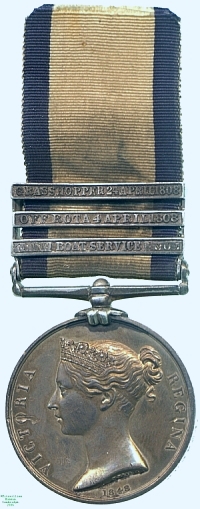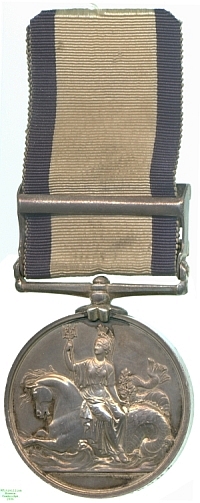
Obverse, a bust of Queen Victoria

Reverse, Britannia with a trident seated sideways on a seahorse

Obverse, a bust of Queen Victoria |

Reverse, Britannia with a trident seated sideways on a seahorse |
Just as in 1848 the extensive land campaigns of the Napoleonic Wars and the other conflicts of the pre-Victorian era were recognised by the issue of the Military General Service Medal, those serving in the Navy at the time were recognised with the Naval General Service Medal. As with the Army equivalent and the East India Company's related award, many of the battles for which the medal was awarded had been fought so long ago that few if any claimants survived.
In addition, bars were awarded for many actions whose significance and size were, despite the heroism displayed by those involved, relatively minor. The result was that many of the bars were issued in tiny numbers, with some combinations all but unique, and the medals command a very high price among collectors because of this rarity and individuality. This in turn, along with the manufacture in most cases of more bars than were eventually issued, has led to the `improvement' of many common awards where recipients' names are shared with those present at `rarer' battles. The medal also shares with the Military General Service and Army of India Medals the oddity that Queen Victoria, whose portrait they bear, was not the ruler under whom the battles for which it was awarded were fought.
The bars on this medal illustrate the sort of minor engagement which the British blockade of the Continental allies often brought about, which the awards committee for the NGSM had not wished to neglect in their issue of bars. The first bar relates to a raid on Muros, near Cape Finisterre, in which a party from HMS Loire landed by boat, forced the surrender of the garrison and demolished their fort, permitting the Loire to capture the two French frigates in the bay without hindrance. The second, Off Rota 4th April 1808, was for an attack by HMSS Alceste, Mercury & Grasshopper on a Spanish convoy off Cadiz, in which they captured seven of the escorted vessels under the eyes of 11 Spanish ships of the line whose commander declined to intervene. 20 days later Grasshopper and another brig, HMS Rapid (whose crew were awarded a separate bar for the same action), attacked another convoy near Faro in Portugal, capturing two of the escorting gunboats and putting the Faro guns out of action.
This medal was awarded to Purser Thomas Bastin, who had the almost unique distinction of being awarded two Naval General Service Medals. One award was with the bar for Boat Service 27th June 1803, when as Clerk aboard HMS Loire he was in a boat party that captured the French brig Venteux off the Isle de Bas. He was still aboard the Loire to win the first bar to this, his other medal, but by the time of the action Off Rota he was Purser aboard the Grasshopper, where he also earnt her eponymous bar twenty days later. His service in these engagements has been verified and the Medal Roll confirms the two issues. Both medals passed into the Hamilton Smith Collection and were thus auctioned by the London auction house of Glendinings in 1927 (21-22 Nov 1927); this piece (which was lot 1139) went to the London dealers Baldwin, and Lester Watson purchased it thence in 1928.